2022 NFL Draft Ultimate Preview: Interior Offensive Line
GREEN BAY, Wis. – Even with five draft picks used the last two drafts, the Green Bay Packers have some retooling to do on the interior offensive line. Here is a look at the State of the Packers and the top prospects in the 2022 NFL Draft.
State of the Packers
With Lucas Patrick off to Chicago and Elgton Jenkins coming off a torn ACL, the Packers have neither a stud blocker nor depth at the guard and center positions.
Last season, with David Bakhtiari out and Jenkins sliding to left tackle, Runyan (sixth round, 2020) started the final 16 games at left guard. Of 63 guards with 50 percent playing time, he finished eighth in PFF’s pass-blocking efficiency with two sacks (both against Washington in Week 7) and 20 total pressures.
Myers (second round, 2021) saw his rookie season torpedoed by injuries. He played about 4 1/2 games during the regular season. Will the Packers forever regret replacing All-Pro center Corey Linsley with Myers instead of all-rookie center Creed Humphrey? Or is Myers’ career poised for a big jump once he gets on the field and stays on the field? Presumably, the presence of Myers means the Packers won’t draft a pure center other than as a late-round depth piece.
Newman was a surprise fourth-round pick in 2021 after starting at guard and tackle at Ole Miss. A scout at the time noted Newman’s position flexibility but said he wasn’t good at any of those positions. The scout was wrong. He started the first 16 games at right guard and finished 39th among guards in PFF’s pass-blocking efficiency with six sacks and 32 total pressures. However, he allowed only one sack during the final eight games.
The undistinguished trio of enter Jake Hanson (sixth round, 2020), guard/tackle Cole Van Lanen (sixth round, 2021) and center Michael Menet (seventh round, 2021 by Arizona) round out the depth chart.
Ranking the Draft Need
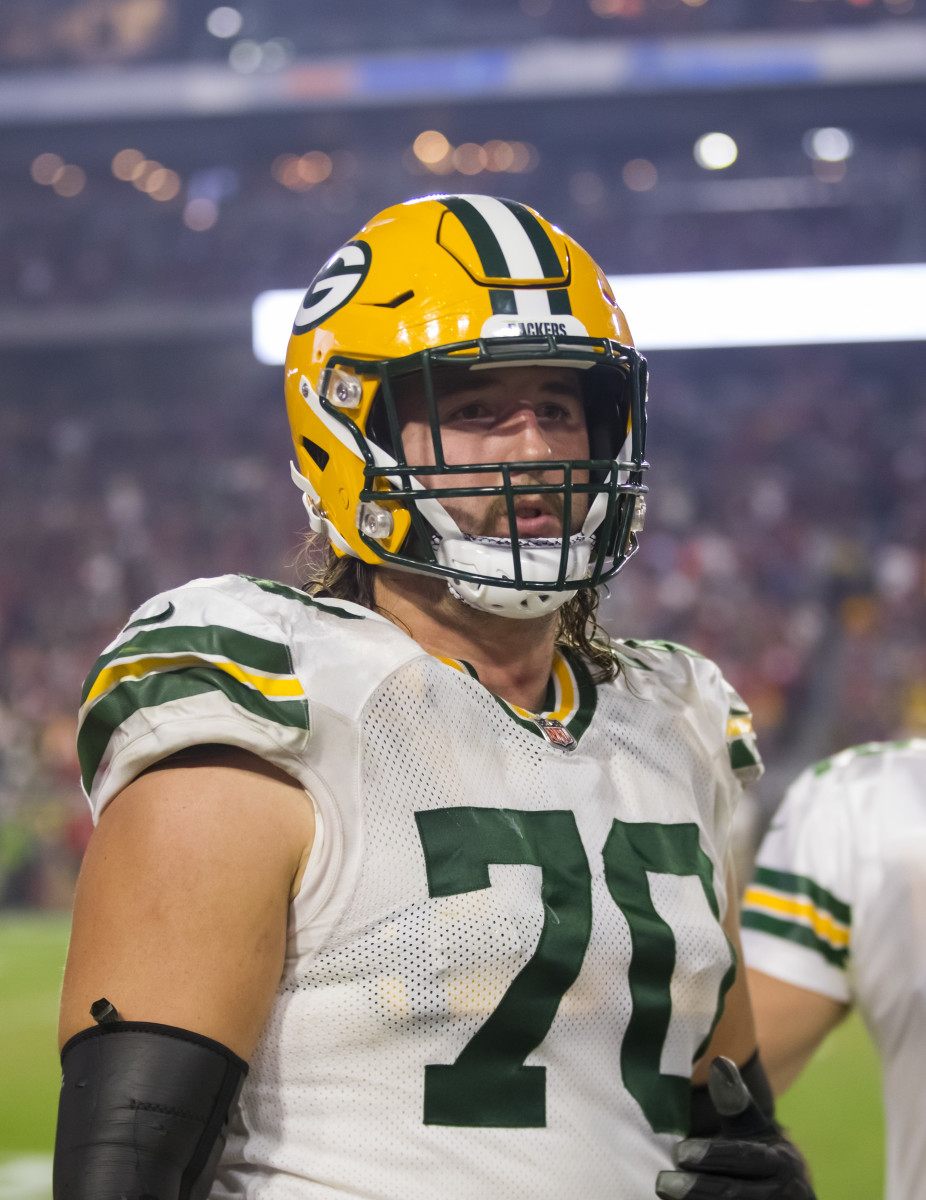
Out of 11 position groups, interior offensive line ranks as the sixth-biggest need. Even without Jenkins, the Packers can line up with Runyan, Myers and Newman as their starting trio. That’s a winning group. But Patrick was an incredibly valuable performer with his three-position versatility.
That being said, whether it's a starter of high-level depth, what the Packers really need is an offensive tackle following the release of starter Billy Turner. However, a once-he’s-healthy Jenkins could move to tackle – a switch he’d probably embrace from a financial perspective – so long as there’s another top-level interior guard on the roster.
Perhaps You Can Forget These Prospects
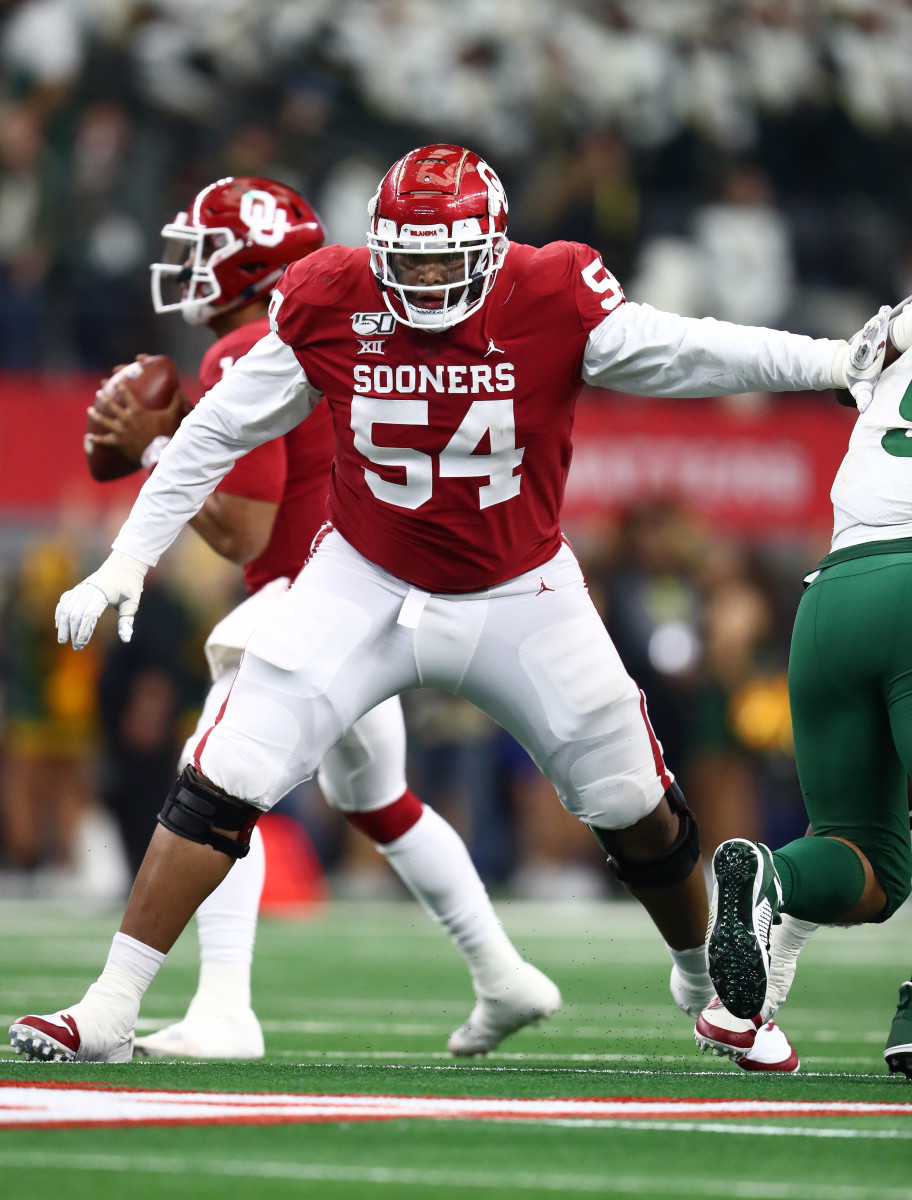
Based on Green Bay’s draft history, the likes of Kenyon Green – a potential first-round pick who started games at four positions last season for Texas A&M – and Oklahoma’s Marquis Hayes might be off the board.
(Note: You’ll find the likes of Wisconsin’s Logan Bruss, North Dakota State’s Cordell Volson, Tulsa’s Chris Paul and San Diego State’s Zach Thomas with the offensive tackles but they might wind up at guard. However, one scout who talked in-depth about the O-line class said they are good enough prospects to warrant a shot at tackle before moving inside.)
Ranking the Offensive Guards/Centers
G Zion Johnson, Boston College
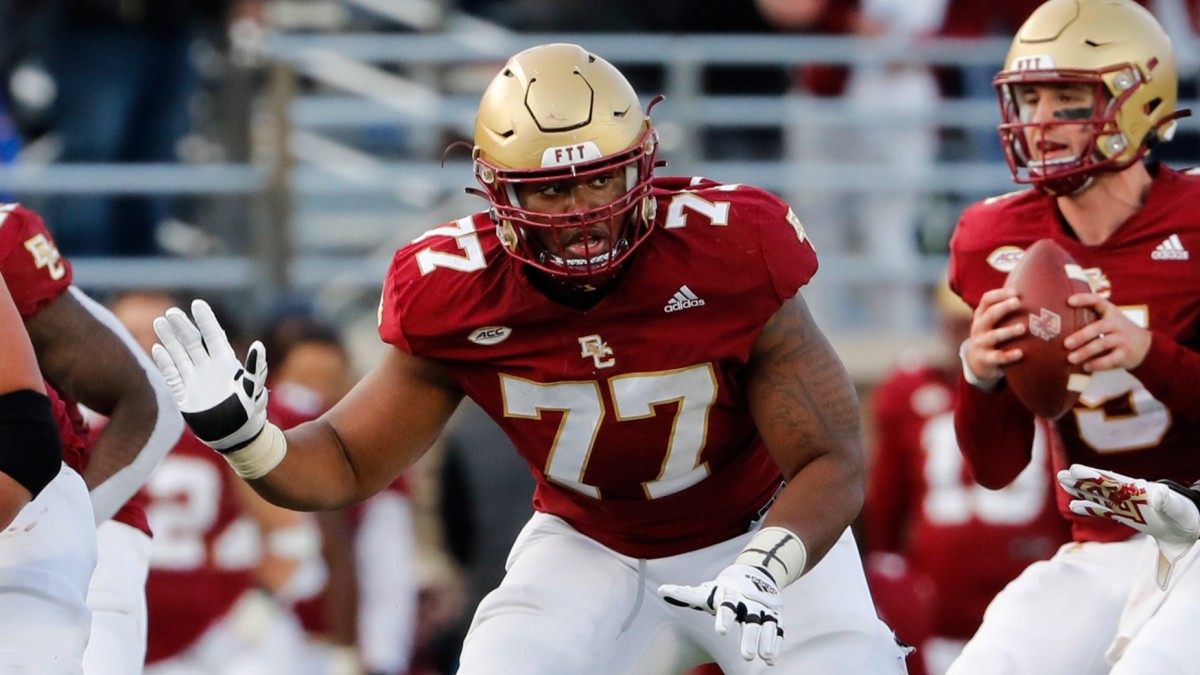
Measureables: 6-2 5/8, 312. 34 arms. 5.18 40, 4.46 shuttle, 32 bench.
Analytical stats: Johnson was a two-year starter at Davidson before moving to Boston College for his final three seasons. He started at left guard in 2019, left tackle in 2020 and left tackle in 2021, when he was first-team all-ACC. According to Pro Football Focus, 67 guards in this draft class played at least 730 offensive snaps. In that group, Johnson ranked eighth in PFF’s pass-blocking efficiency, which measures, sacks, hits and hurries per pass-protecting snap. He was charged with one sack. According to Sports Info Solutions, backs averaged 2.1 yards before contact on runs to his gap, just 19th among the 24 guards it ranked in the draft class. Backs bounced the run past his gap 29 percent of the time, tied for 13th.
Personal touch: “Coming out of high school the only school that recruited me was Davidson, which is a non-scholarship team,” Johnson told The Boston Herald. “They don’t offer scholarships and for financial reasons I could no longer go there.” For financial reasons, Davidson was given a waiver to play at Boston College immediately rather than sitting out a year.
Amazingly, Johnson didn’t play football until his senior year of high school. “I’m pretty sure my freshman year of high school I was maybe 5-foot-9, 5-foot-10, maybe 190 to 200 pounds,” Johnson said in an interview on Packer and Durham. “I played golf eighth grade to junior year. My junior year I was probably around 6-foot-1, 6-foot-2, 220 pounds, and I played my senior year at 225 to 230 pounds at right tackle.”
He has size-18 shoes and helped power AJ Dillon. “I always say that if you don't love football, you're not going to go very far," Johnson said at the Scouting Combine. "Because when you get in those hard moments, when you're tired, something’s not feeling right, you have to fall back on something. And if it's superficial, you're not going to be able to sustain that.”
NFL Draft Bible Scouting Report: Johnson primarily wins with an easy anchor to withstand contact to his frame; he also has a strong trail arm to slow opponents down. His flexible hips, back and ankles help him stand opposing players up. Johnson routinely seals defenders. What’s more, his persistent leg drive and strong grip after initiating help him generate power and sustain blocks. The Maryland native has a knack for using defenders’ momentum to wash them out of plays. He easily overpowers linebackers and flashes dominance in double teams.
C Tyler Linderbaum, Iowa
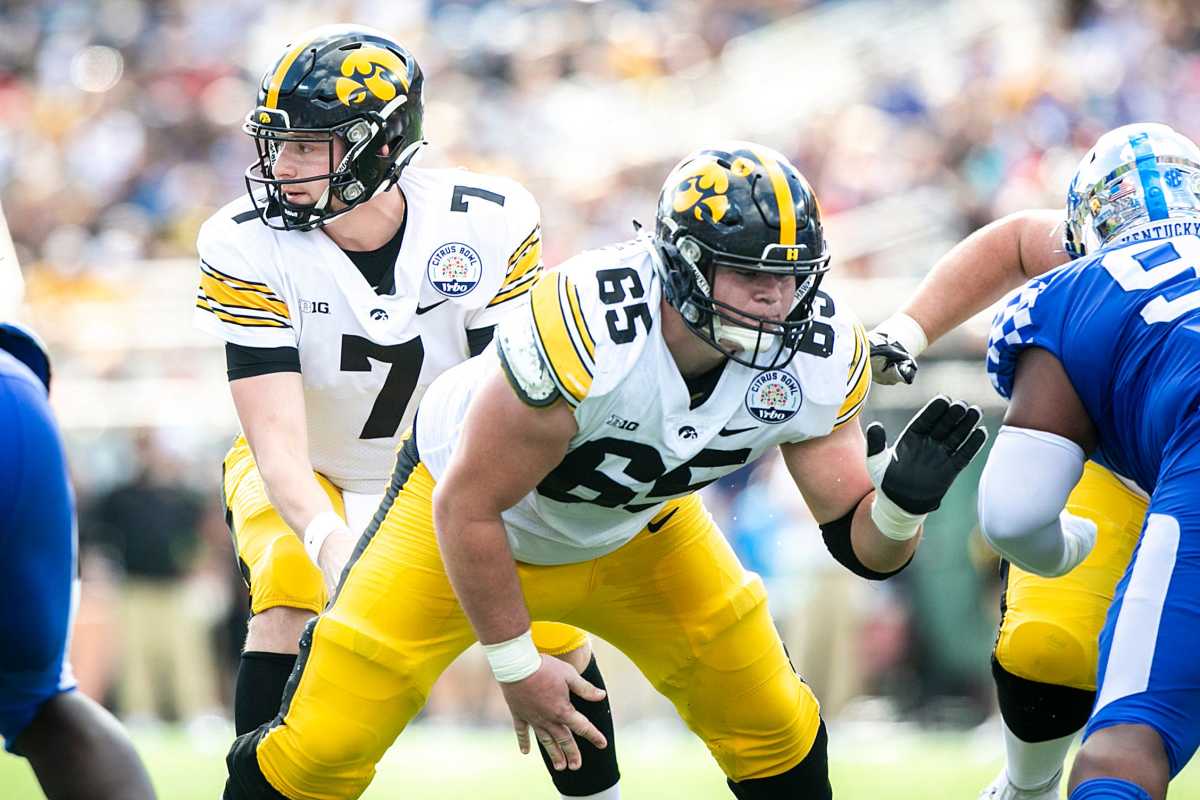
Measureables: 6-2 1/8, 296. 31 7/8 arms. DNP workouts (foot).
Analytical stats: Linderbaum was a three-year starter at center. He was a two-time first-team All-American and winner of the Rimington Award as the nation’s top center in 2021. During his final season, he gave up one sack. Of the 58 centers in the draft class with at least 650 snaps last year, he ranked ninth in its pass-blocking efficiency. According to Sports Info Solutions, backs averaged 1.4 yards before contact on runs to his gap, last among 19 centers it ranked in the draft class. Backs bounced the run past his gap 31 percent of the time, good for sixth. He was not flagged for holding.
Personal touch: A native of Solon, Iowa, he finished fifth at the state wrestling tournament as a junior and third as a senior, and totaled 122 career wins. Among his wrestling rivals was former Iowa teammate and Tampa Bay Buccaneers standout Tristan Wirfs.
“Our high schools are rivals in Iowa,” Linderbaum said at the Combine. “We've always competed against each other, whether it be football, baseball, wrestling, track, obviously wrestling. I've wrestled him quite a bit. He's beaten me quite a few times. I'm happy I got one match on him, but he's a great competitor. He's someone who's made me better whether that'd be in high school and then going into college. He's someone that I can really look up to that set kind of the standard at the offensive line position.”
A wrestling background is generally a strong asset for an offensive lineman. “Wrestling has helped with a lot,” Linderbaum told The Gazette. “Just from the mental side of things. It will help me for the rest of my life, going through all those hard practices (and) matches and just to fight through it. I think that is one of the biggest things. Also, I think I have gotten better with my hands and feet, knowing how to use leverage.”
He spent his redshirt season of 2018 on the defensive line. That’s the position at which he was a high school All-American. At first, he was disappointed. “It was kind of a natural,” coach Kirk Ferentz said. “If we had three of them, we’d have him playing center and the other two guys would be playing guards. He’s one of those football players who can do a lot of things and he’s a delight to have on the team.”
NFL Draft Bible Scouting Report: For an undersized offensive lineman, his strength is absolutely phenomenal. A former high school state champion wrestler, firmly understands how to use his hands and basically wins every battle in the trenches. Athleticism and overall movement skills are scary - is able to move up the field like a tight end and generates some massive pop when he reaches the second level. Snaps the football with impeccable precision and his conversion to blocking is clean and crispy.
Of note: Due to height and length issues, he’s a center-only and presumably won’t be a consideration.
G/T Kenyon Green, Texas A&M
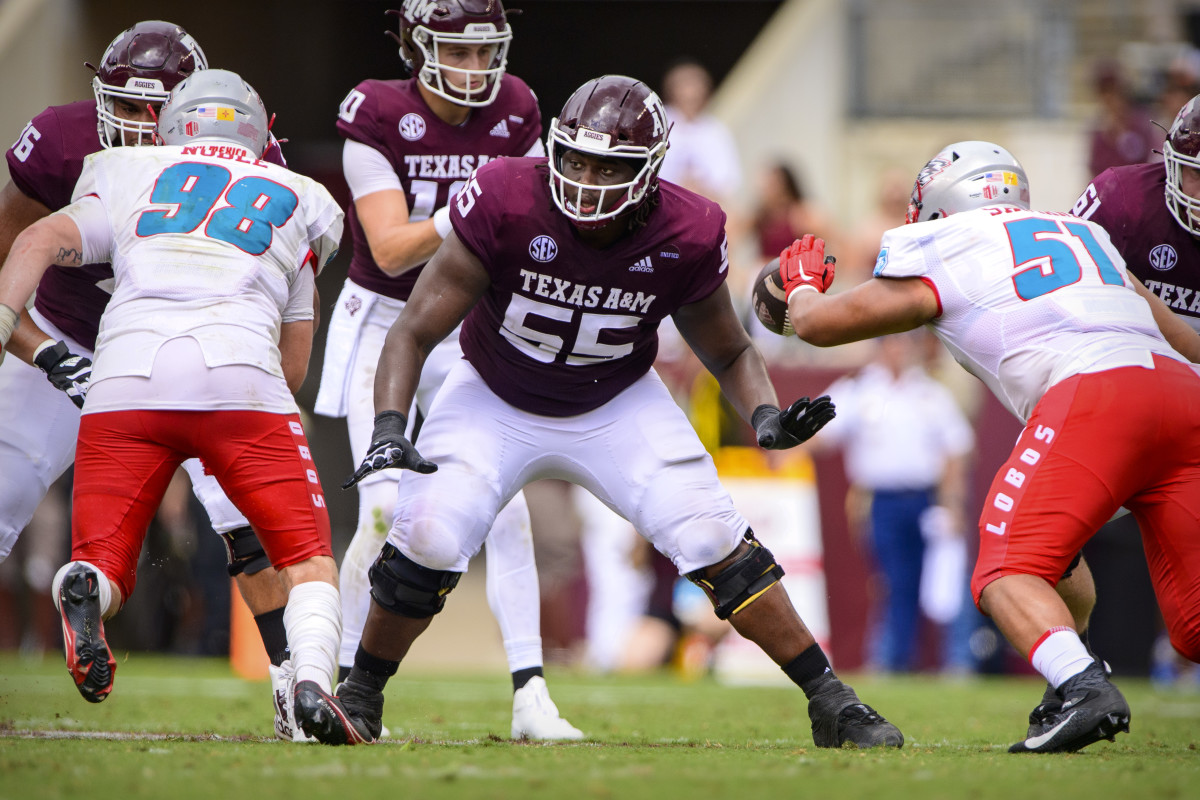
Measureables: 6-3 7/8, 323. 34 1/8 arms. 5.24 40, 5.12 shuttle, 20 bench.
Analytical stats: Green was a three-year starter for the Aggies. He was a consensus All-American at left guard in 2020 and a consensus All-American when playing here, there and everywhere in 2021. Amazingly, he got seven starts at left guard, two at right guard, two at right tackle and one at left tackle last year. He was charged with one sack and ranked 20th in PFF’s pass-blocking efficiency, though he obviously faced a different kind of player while at tackle. According to Sports Info Solutions, backs averaged 2.0 yards before contact on runs to his gap, just 21st among the 24 guards it ranked in the draft class. He was flagged for holding six times, tied for the most among guards. Backs bounced the run past his gap 49 percent of the time, worst of those 24. Again, he faced a different player at tackle than he’ll face at guard, but the run-game numbers weren’t appreciably better in 2020 (2.1 yards before contact, 43 percent bounce rate).
Personal touch: Green’s path to the draft started with his father making a car comparison. Green was a standout defensive lineman on his high school team but his coach wanted him to move to left tackle. So, the coach approached Green’s father to get some help in convincing Kenyon.
“He was kind of bummed," Henry told TexAgs.com. "I told him to start doing your research on the (professional) longevity of a defensive tackle versus an offensive lineman. I asked him, 'What's the highest-paid position on the field?' He said, 'Quarterback.' So, I said, what's the second-highest? 'Offensive tackle.' I told him if you're going to have a Maserati, you've got to have insurance.”
Green’s father, Henry, played guard at Grambling State; his mom, Shalonda, played volleyball at UCLA.
"The one thing that I really think highly of him is he's a God-fearing young man," Henry said. "He never gave me a sleepless night. He never got in any trouble. He makes me very proud."
NFL Draft Bible Scouting Report: Green is a thickly built offensive guard at Texas A&M who shows elite traits to be a great pass protector at the next level right off the bat. He relies on extremely good balance and a wide base to give himself the platform to succeed on every down. Only legitimate concern is his somewhat limited athleticism that hinders his ability as a vertical run blocker climbing to the second level.
Of note: Green’s 20-yard shuttle time is far slower than any run by a Packers lineman since the switch to the zone scheme in 2006. The guess is Green will not be a consideration but he is listed here because he has been mocked to the Packers several times.
G/C Cole Strange, UT-Chattanooga
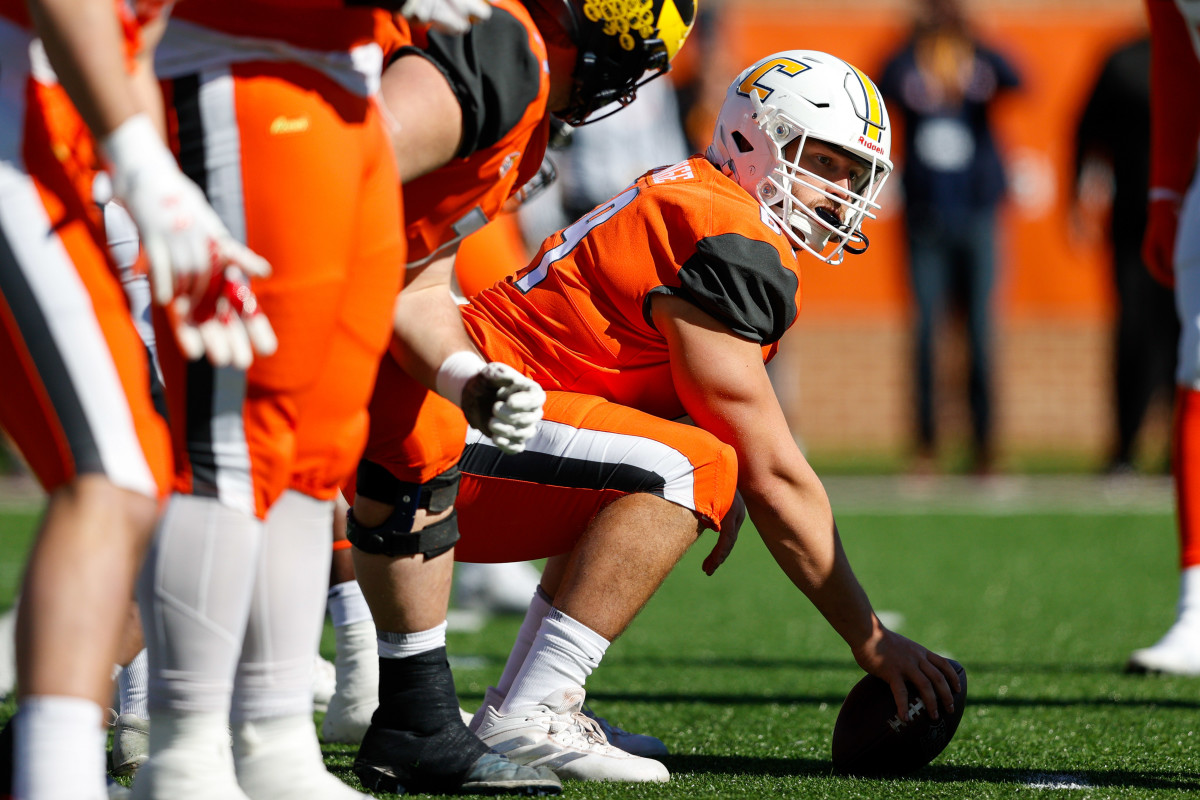
Measureables: 6-4 7/8, 307. 33 arms. 5.03 40, 4.50 shuttle, 31 bench.
Analytical stats: Strange started 44 games, with 42 of those coming at left guard. He was a first-team FCS All-American as a senior. According to Pro Football Focus, he allowed one sack and five total pressures in 2021.
Personal touch: Growing up in Knoxville, Tenn., he was a stud linebacker as a junior and defensive end as a senior. He also played tight end. In 2016, his redshirt season, he made the move to the offensive line. A year later, he was a Freshman All-American at guard – a position he’d never played.
“I think it's just I look at it as it's the only place you can just kind of be a dickhead,” Strange said of being a lineman at the Combine. “You know, you can hurt somebody, you can bury somebody, you can kind of give an elbow in their neck. And people kind of revere you for that. And also, it's just fun, you know? Yeah, I just enjoy that.”
The step up in competition wasn’t a problem at the Senior Bowl, where he mostly played center. "He has that true old-school offensive lineman mindset," UTC coach Rusty Wright told The Times Free Press. "You get lined up, and it doesn't make a crap who's on the other side of you. You just go get after it and go get it done. That's him, and it's with everything he does. If you tell him he's not going to be good at something, he'll show you. That's why those guys love him at that level. His personality will help him a bunch."
Strange initially committed to Chattanooga before flipping to Air Force. He had a change of heart, though, and wanted to play closer to home. So, it was back to UTC. “I kinda came to realize that if I signed with Air Force, I’d see my family maybe two weeks in a year,” he told The Touchdown UK. “As a prep school guy, I’d be in Colorado Springs for five years, so I would probably have seen my family for a month and a half total in half a decade. Ultimately I wanted to stay close to home, and I went to Chattanooga. And it’s not like I look back and think ‘what if’. I have no regrets about my decision.”
NFL Draft Bible Scouting Report: When evaluating prospects who primarily play against lower levels of competition than do those at big-time programs, it is crucial to see them dominate regularly. A clear NFL talent at the FCS level, Cole Strange is a smooth and quick mover who can be used creatively in the run game and pass protection. He gets to space on screens and outside run concepts; he also mirrors well both before and after engaging. Strange has loose hips to hinge and seal. The Mocs’ standout wins with persistent leg drive and people-moving power at the first and second levels of the defense.
G/T Luke Goedeke, Central Michigan
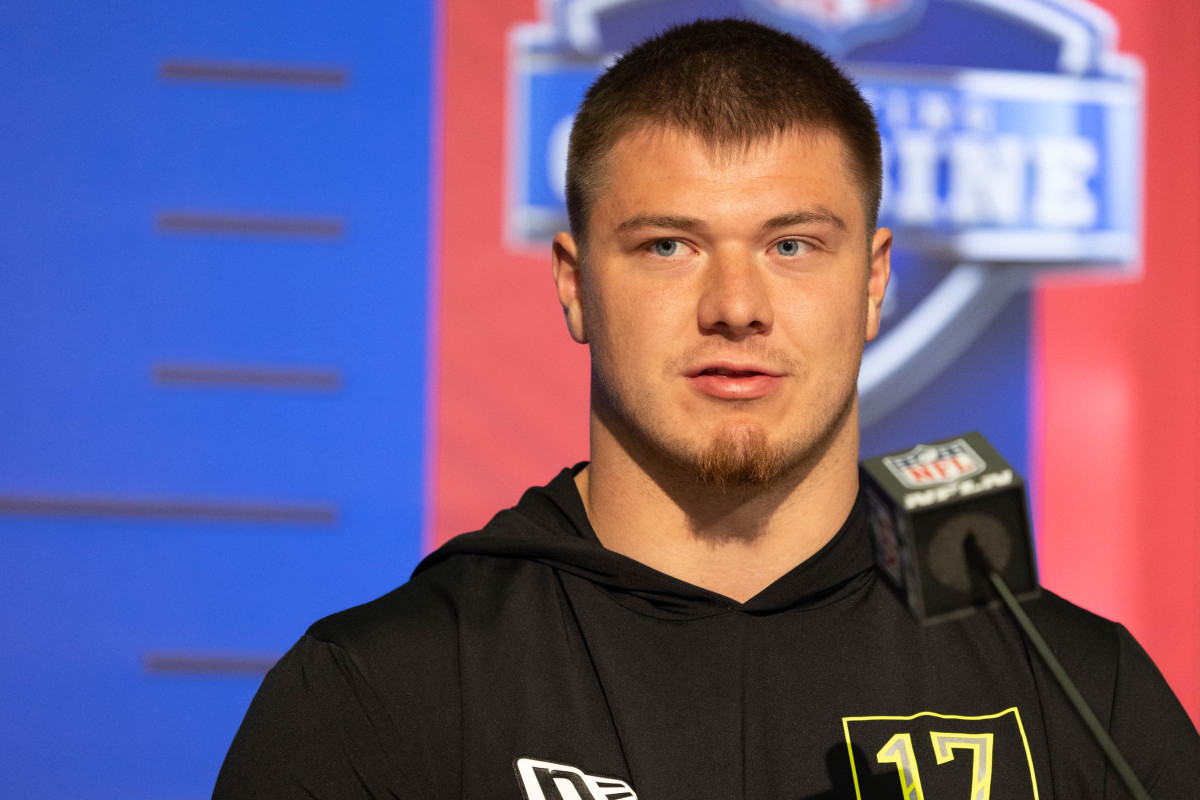
Measureables: 6-5, 312. 32 1/4 arms. DNP 40, DNP shuttle (hamstring), 27 bench.
Analytical stats: Goedeke’s college career started as a tight end at Wisconsin-Stevens Point, a Division III program. He transferred to Central Michigan, where he redshirted and bulked up in 2018. He started all 14 games at right tackle in 2019, sat out 2020 due to injury, then started 10 games at right tackle in 2021. According to PFF, he allowed zero sacks and seven total pressures last season. According to Sports Info Solutions, backs averaged 3.2 yards before contact on runs to his gap, third among the 24 guards it ranked in the draft class. Backs bounced the run past his gap 23 percent of the time, tied for second.
Personal touch: A native of Whitelaw, which is located about 45 miles south of Green Bay, Goedeke started his career at Division III Wisconsin-Stevens Point. He caught 12 passes in 2017 but wasn’t satisfied with being a freshman starter.
“Being a Wisconsin kid, going to 20-plus Badger games throughout my life, I bled Badger red and white through and through,” Goedeke, who had a predraft visit with the Packers, said at the Scouting Combine. “So, that was my dream was to go to play for the Badgers and play in the NFL one day. Unfortunately, in high school, to be honest, I didn’t have a recruiting process. I was negative two stars, if you can believe that.”
So, Goedeke went to Stevens Point, working toward two majors (chemical engineering and paper science) while on a two-year plan.
“I had this mind-set like, ‘All right, I got to start somewhere. I’m not giving up this dream,’” Goedeke said. “That’s not who I am at the end of the day. I’m a grinder. So, I played at the Division III school, ended up starting as a true freshman, and then had a plan that it would take two years to try and transfer to a Division I school. Surprisingly, thankfully, it only took one.”
NFL Draft Bible Scouting Report: Goedeke has sufficient movement skills to get to space and be used creatively in the run game. He can mirror once engaged. The Central Michigan standout wins primarily thanks to his power. Goedeke drives most defenders off the point of contact with leg drive and pure strength. Once he latches on, the athletic tackle takes defenders for a ride. Goedeke has notable grip and core strength to sustain blocks. In the run game, the former tight end looks for work, engages well in space, and dominates smaller opponents. He has a finisher’s mentality.
Of note: Short arms probably will move him to guard.
G/T Sean Rhyan, UCLA
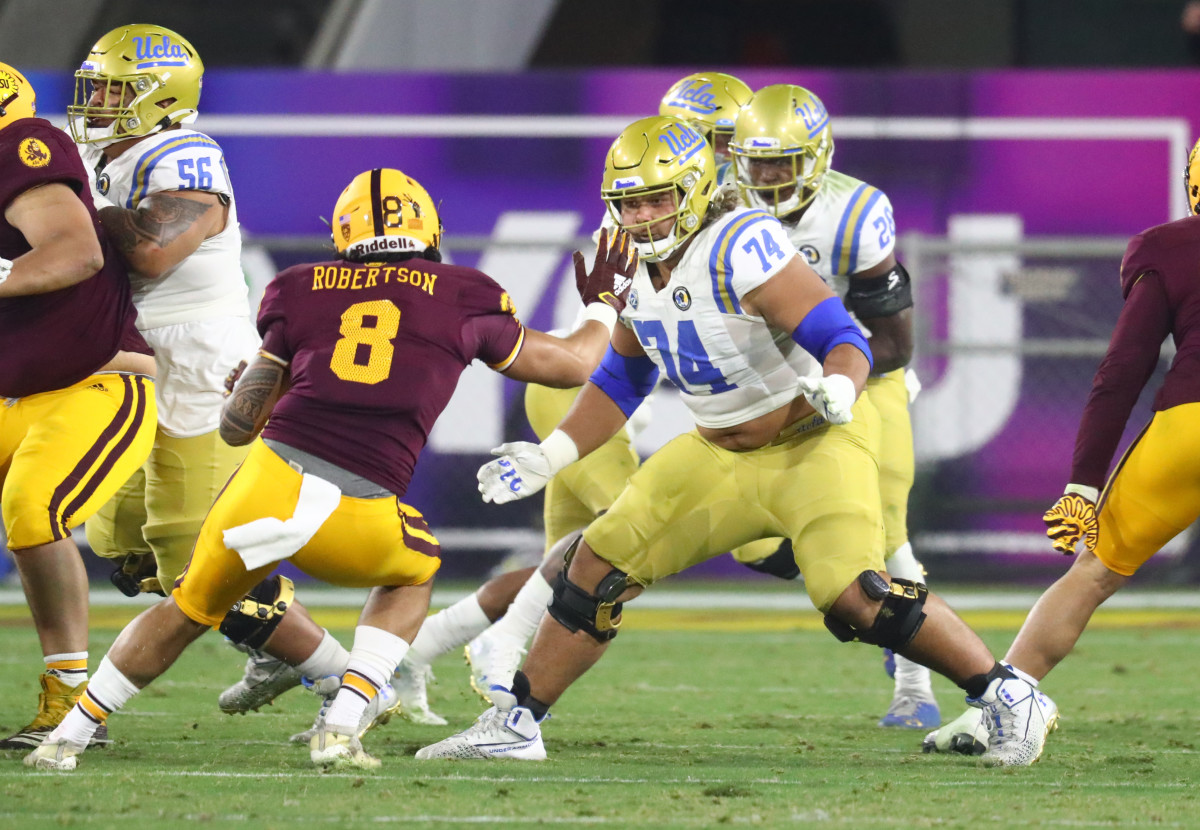
Measureables: 6-4 5/8, 321 pounds. 32 3/8 arms. 5.25 40, 4.60 shuttle, 21 bench.
Analytical stats: Ryan started all 31 career games at left tackle. He was a Freshman All-American in 2019 and first-team all-conference in 2021. His PFF numbers are incredible. In 2019, he allowed one sack and 37 pressures. In 2021, he allowed one sack and 13 total pressures. According to Sports Info Solutions, backs averaged 3.0 yards before contact on runs to his gap and bounced the run past his gap 21 percent of the time, the latter figure ranking No. 1.
Personal touch: Rhyan was late to the game. He was too busy surfing, playing violin and competing in judo, baseball and rugby – the latter of which he was good enough to be considered for the U.S. Olympic rugby program. Five games into his high school career, he collected his first major offer.
“He grew up on the beach, obviously because it was cheap and it was fun,” his father, Steve, told 247 Sports. “He grew up boogie boarding and he graduated to a surfboard around five or six.” Added Rhyan: “We used to go Hawaii a lot so I would go and skim board and run on the beach. I think that helped with my balance.”
In an interview with Rivals, Rhyan recalled the start of his football career in the eighth grade at Capistrano Valley Christian Schools: “I was right tackle and started. First play of my football career I got pancaked by a D-end. I was like, ‘Oh, man, that’s not going to happen again.’ The next play I kind of hit him and I was like, ‘That was somewhat fun.’ So … I like hitting people on the line. That was fun. But I also enjoy tackling people, because that’s also fun. It attracted me in that way.”
Steve Rhyan was a professional motocross racer and his grandfather was a professional boxer. “(All the sports) kind of intertwine,” Rhyan told The Orange County Register. “Shot put helps with my kick slide, kind of helps my legs be powerful. The surfing (helps) with balance. The rugby (helps) with tackling and running correctly. … Just playing around got me ready to pursue whatever I want.”
NFL Draft Bible Scouting Report: Athletic tackle who is explosive in his sets to match rushers to the apex while not allowing his process to be sped up and maintaining great knee bend. Rhyan runs speed rushes around the pocket while continuing to land strikes. He combats defenders that lock out with his snatch trap technique. His balance helps him replace his hands through reps. Rhyan possesses excellent core strength that allows him to anchor and stall power rushers from unfavorable positions. In the run game, he twists and seals opponents on the perimeter further displaying his strength. He finishes off-balance defenders with his strike and drives smaller opponents.
Of note: Short arms might necessitate a move to guard.
G Jamaree Salyer, Georgia
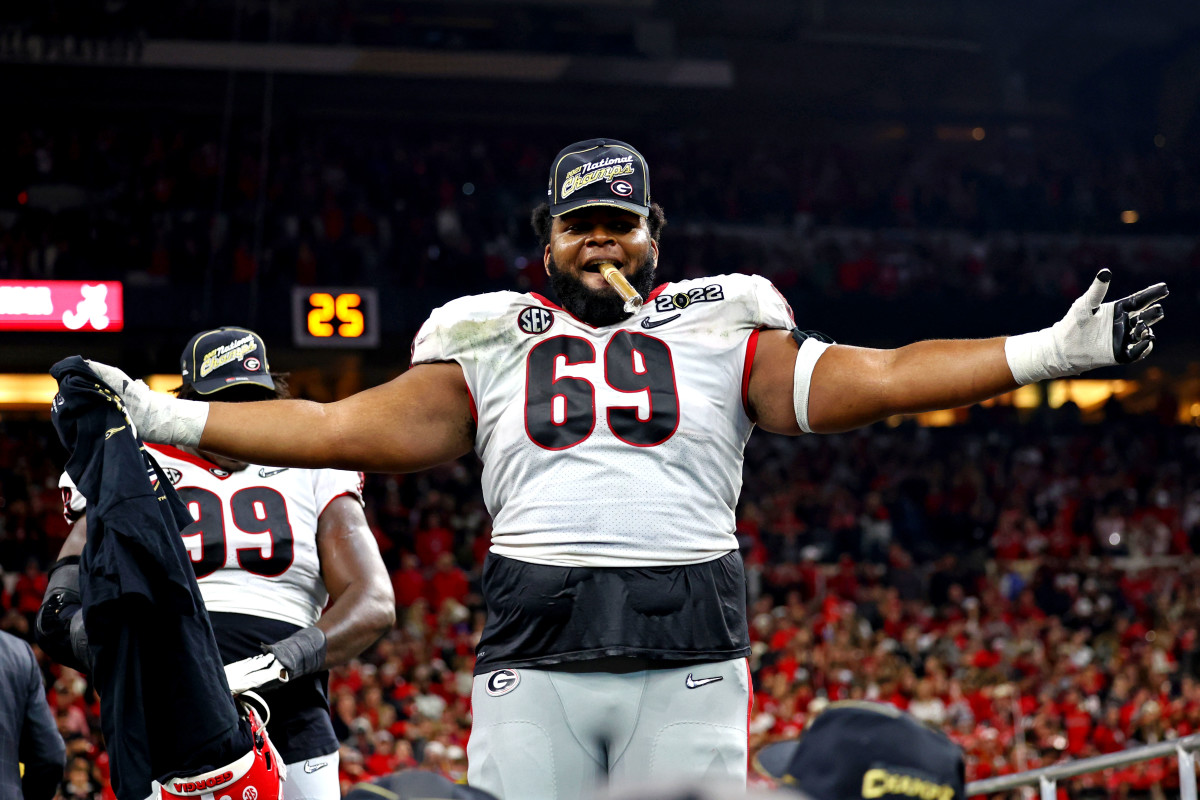
Measureables: 6-3, 321. 33 5/8 arms. DNP 40, 4.70 shuttle, 31 bench.
Analytical stats: Salyer was the Bulldogs’ starting left tackle the last two seasons. He earned second-team All-American as a senior. According to PFF, he allowed just one sack and 13 total pressures in his two seasons at left tackle. According to Sports Info Solutions, backs averaged 2.6 yards before contact on runs to his gap, 12th among the 24 guards it ranked in the draft class. Backs bounced the run past his gap 23 percent of the time, tied for second – and that’s while at tackle.
Personal touch: Salyer was the No. 1 guard recruit in the nation and high school teammates with another Georgia stud blocker, Andrew Thomas. Salyer starred at left tackle for the Bulldogs but, in the national championship game, he moved to right guard to help power the victory. “Even me at one point, I went over to Coach (Kirby) Smart and was like, Put it on us. We want to win this game. That kind of sparked it off, got it going for us,” he said afterward.
Salyer figures to move to guard – and stay there – in the NFL. “It is weird. I was really great as a guard coming out of high school, but it’s weird being 6-foot-3, 6-foot-4 and having a body frame, I would have never predicted that I play tackle in college,” he told Bulldawg Illustrated. “I am not really sure which one I am better at, I take pride in being the best I can be at both, and even at center too. So, yeah it is kind of hard and kind of a hard question to ask, but like I said I embrace the challenge every day and I try to be the best I can at either one of them and try not to measure them.”
Before the 2020 season, he shed 15-plus pounds by trading fast food for grilled salads from Chick-fil-A. "I just knew that the weight thing was going to be a big contributor to where I could be, and that it would raise my potential," Salyer said before the season. "That was my goal going into the first quarantine — just to raise the bar for myself. I knew I could play tackle. I knew I could play guard. I knew I could play any of those positions at a much higher level if I lost the weight. My goal was to originally get to 315, but that has turned into 309. I'm sitting right about 315 right now, so I lost about 20 pounds in quarantine, and losing that weight has helped me out a lot for sure."
NFL Draft Bible Scouting Report: He is a technically sound and poised pass protector who maintains good balance and composure. Salyer keeps his feet moving and replaces his hands urgently, showing a good reactive punch as defenders rarely beat his hands. His grip strength is good when he can attack the frame of defenders and makes him difficult to deconstruct. Salyer creates a push with above-average leg drive in the run game.
Of note: Due to height issues, he’s destined to move to guard. He didn’t go through athletic testing but his film shows he might lack the requisite athleticism the Packers prefer.
G/T/C Zach Tom, Wake Forest
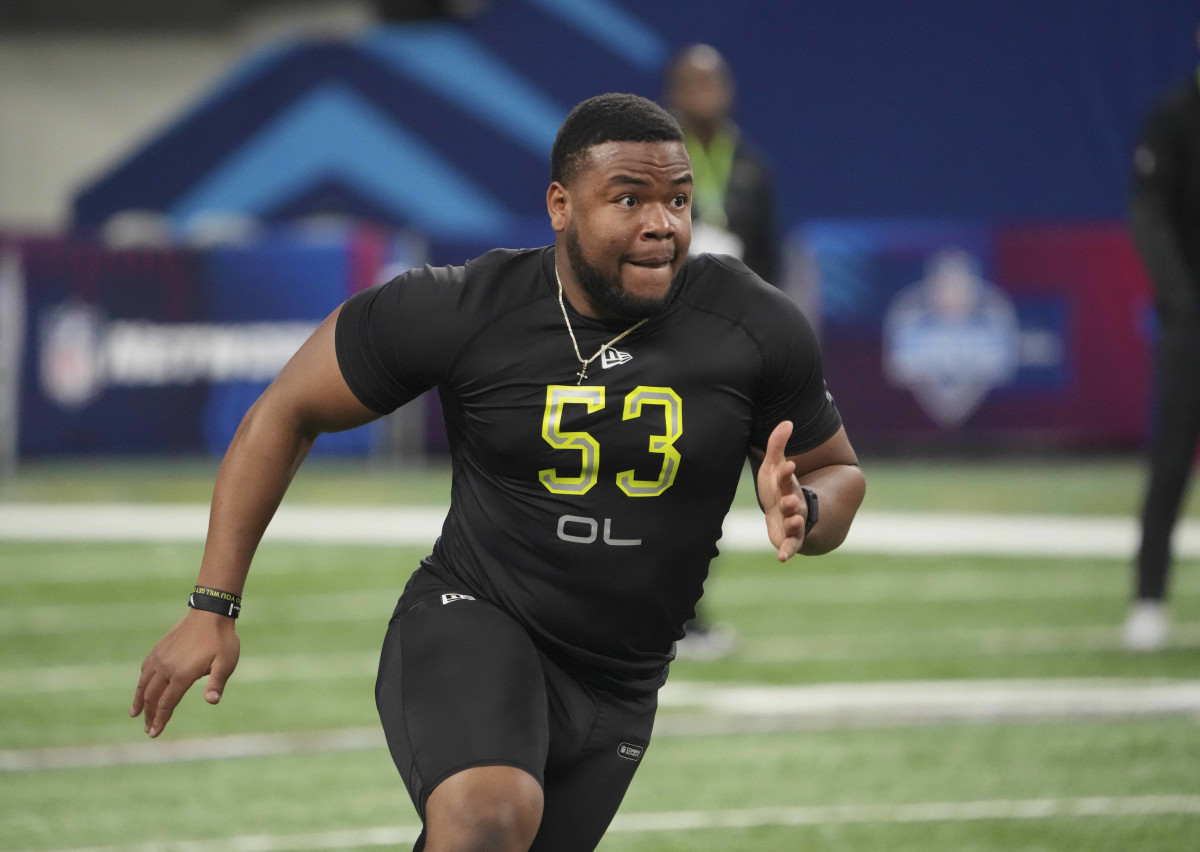
Measureables: 6-4 1/4, 304. 33 1/4 arms. 4.94 40, 4.47 shuttle, 24 bench.
Analytical stats: Tom started at center in 2019 and at left tackle the last two seasons. He was a second-team All-American in 2021 and won the Jim Tatum Award, which goes to the ACC’s top senior player.According to PFF, he allowed zero sacks during his one season at center. As a senior, he yielded three sacks and 13 total pressures. According to Sports Info Solutions, backs averaged 2.4 yards before contract with a bounce rate of 36 percent.
Personal touch: Tom’s older brother, Cameron, was a four-year starter on the Southern Miss offensive line. He’s played in 13 games since entering the NFL in 2017, including one game for Miami last season. In August 2018, both players played in New Orleans on a Thursday night: Zach for Wake Forest against Tulane and Cameron for the Saints in a preseason game against the Rams.
"They always got good grades and did well in school," their mom told NOLA.com. "We thought they would just graduate (from high school) and go to LSU on TOPS (scholarship program). Then the college coaches started calling, and we thought, 'This is real now.'"
Their father is from Nigeria. "The small towns in Africa have no electricity, much less TVs and computers," he said. "And that would have been my life if I hadn't gone out. My original goal was to go back to the village and teach elementary school. My original goal was to go back to the village and teach elementary school. When I was finishing high school, if I had stayed back that's probably what I'd be doing."
NFL Draft Bible Scouting Report: Tom has long legs and an athletically built frame. Looks more like a “beefed up tight end” than offensive linemen. Impressive kick slide as he has smooth hips and quick feet, allowing him to get set quickly. His agility frequently shows as he can down-block then turn and pick up delayed or re-tracing defenders. Rarely oversets but has the ability to get inside due to his sharp short-area quickness.
C/G Dylan Parham, Memphis
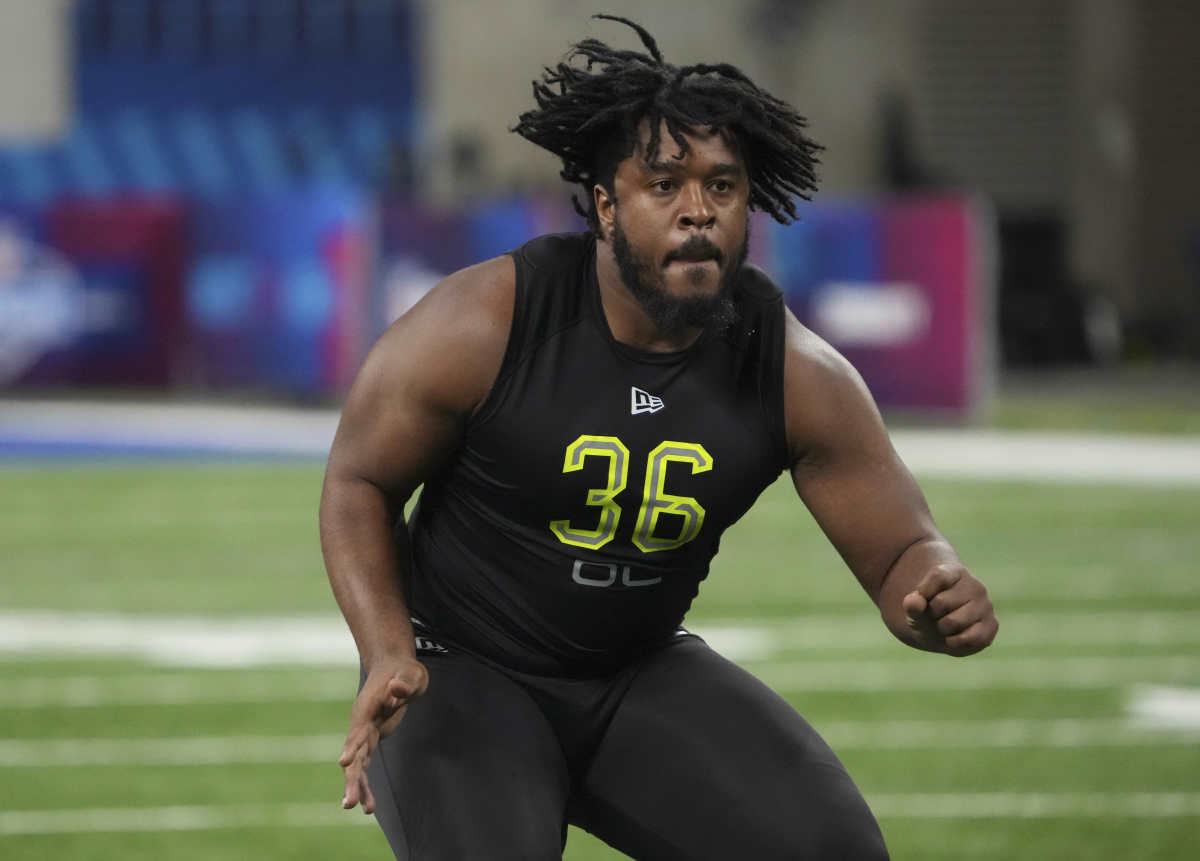
Measureables: 6-2 5/8, 311. 33 1/8 arms. 4.93 40, 4.70 shuttle, 25 bench.
Analytical stats: Parham started all 28 games at left guard as a freshman and sophomore, all 11 games at right tackle as a junior and all 12 games at right guard as a senior. He allowed zero sacks and ranked eighth among guards in the draft class in PFF’s pass-blocking efficiency. According to Sports Info Solutions, he ranked 15th out of guards with 2.4 yards before contact and fifth with a bounce rate of 27 percent. He was not flagged for holding.
Personal touch: You want athleticism from your linemen? In 2014, he competed at the National Junior Olympic Championships in the triple jump. He played tight end in high school.
“I would say the tight end position definitely helped me, made me more versatile,” he said at the Combine. “Going to run routes and blocking on the inside, blocking defensive ends, still having that same footwork, same speed. That transition definitely helped me just having the mindset to learn right tackle, right guard. I know every position on the offensive line. I feel like that will definitely help me at the next level.”
NFL Draft Bible Scouting Report: With a stout build, Parham is able to come off the ball with low. His pad level stays low throughout the rep and keeps himself underneath the defender. Smooth mover in space, Parham pulls out in space well and can block downfield. Lines up defenders at the second level, keeps his eyes in the right area. Posture in pass protection is good, keeps a flat black and sinks into his hips.
Of note: Due to height issues, he might be forced into center-only duties and presumably won’t be a consideration.
C Cam Jurgens, Nebraska
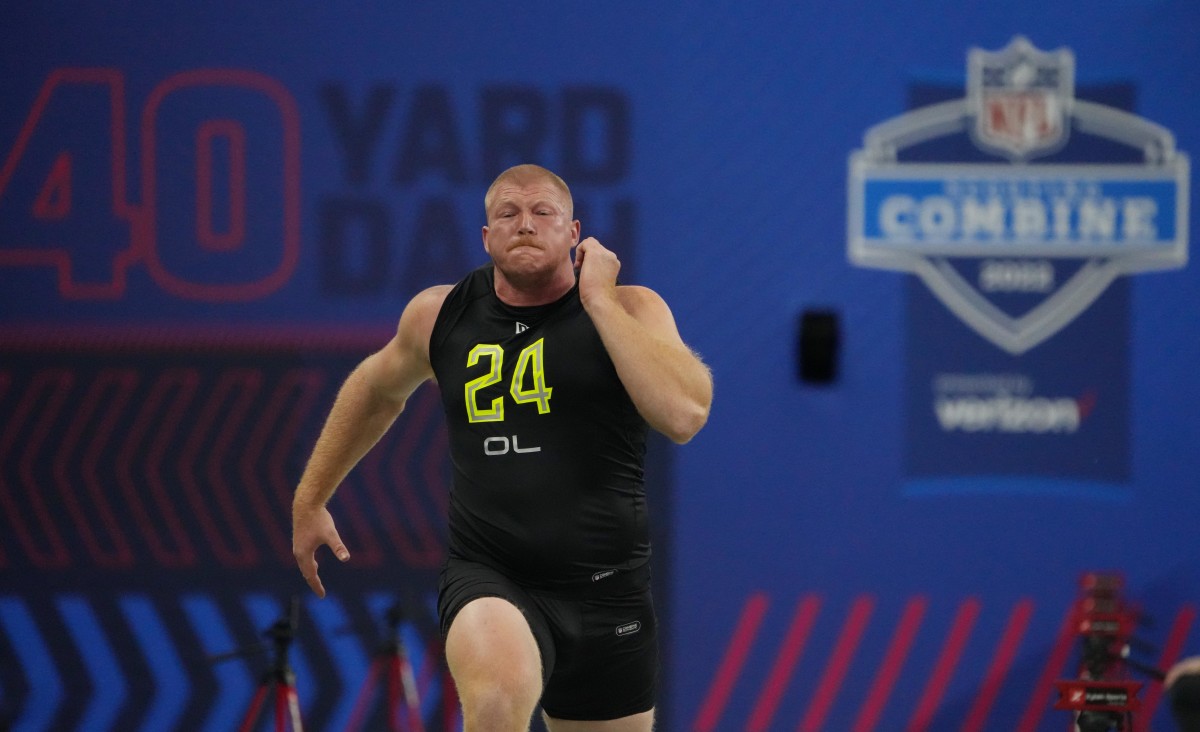
Measureables: 6-2 7/8, 303. 33 3/8 arms. 4.92 40, 4.49 shuttle, 25 bench.
Analytical stats: Jurgens started 31 games at center during his final three seasons. He was third-team all-conference in 2021. He allowed zero sacks and ranked 33rd among centers in the draft class in PFF’s pass-blocking efficiency. According to Sports Info Solutions, backs averaged 1.9 yards before contact on runs to his gap, 16th out of 19 centers it ranked in the draft class. Backs bounced the run past his gap 33 percent of the time, good for eighth.
Personal touch: At Beatrice (Neb.) High School, Jurgens was an all-state performer who stuffed the stat sheet with tackles, catches and rushing yards. He started his redshirt season of 2018 as a tight end before a life-changing conversation with then-coach Scott Frost.
“I didn’t see it coming,” he told The Journal-Star. “Coach Frost came and talked to me, and asked what it means to play for Nebraska. I was like, ‘Oh, maybe he’s thinking D-line or something,’ and then he pulled out center. I’m like, ‘All right, yeah.’ I kind of went with it and trusted him, and now I’m here.”
The move to center marked his first time on the offensive line since third grade. “My mindset has completely changed,” Jurgens added. “I didn’t realize how much I didn’t like going out for routes until I didn’t have to. I don’t have to run 20 yards and not have a ball thrown your way. I can just go block someone. I’ve enjoyed it a lot.”
In high school, he was a four-time state champion in the discus and three-time champion in the shot put, and he dabbled in the shot a bit at Nebraska. Those are the sports his mom absolutely dominated at Nebraska-Kearney. “The thing I like about Cameron — and I don’t think I coached it to him — but it’s just that he has that ability to handle the pressure situations,” Beth said. “You know, to stay calm, and not get too worked up.”
NFL Draft Bible Scouting Report: Jurgens has some athletic traits that are rare out of college centers with quick feet, loose hips, and excellent short-area agility. His lack of mass and firm base occasionally causes a lack of balance and allows opposing linemen to overpower him. Time in an NFL strength and conditioning department will suit him well and could propel him to a solid NFL career.
Of note: Due to height issues, he’s a center-only and presumably won’t be a consideration.
G/T Joshua Ezeudu, North Carolina
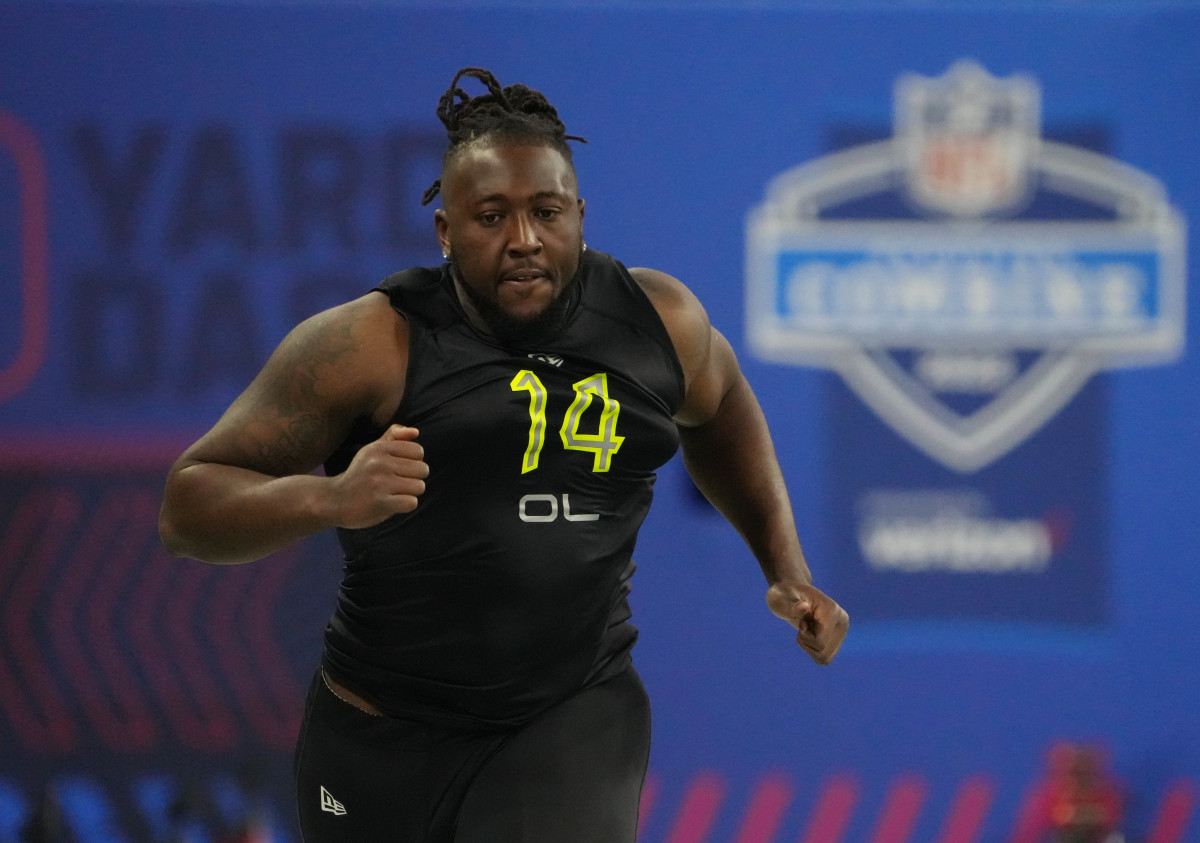
Measureables: 6-4 1/8, 308. 34 arms. 5.19 40, 4.56 shuttle, 20 bench.
Analytical stats: During his final three seasons, Ezeudu started 20 games at left guard, six games at left guard and two games at right tackle. He was an honorable mention on the All-American team in 2021, when he started seven times at left guard and four times at left tackle. According to PFF, he allowed two sacks and ranked 49th out of 67 guards in the draft class in its pass-blocking efficiency. According to SIS, backs averaged 2.6 yards per run to his gap and bounced it past his gap 36 percent of the time.
Personal touch: In 2020, he conducted his first interview with Tar Heels beat reporters. But first, he had an important announcement. “Before we start,” he said in a feature by Inside Carolina, “I would just like to tell you guys that I stutter, in case I do stutter now – which I do not plan on doing. But we can continue, though.” Twenty years of speech therapy got him mostly past his impediment.
His first-person account of his life story was published by Newsweek. “Developing confidence has really helped me. And I try to keep my stress levels down, because it's important to be calm and not scared to stutter. Most stutterers would probably agree that the times they are nervous and uncomfortable are when they stutter the most. For me, it's important to accept that I am stuttering and that I will talk how I talk. I can't be scared to speak up.”
His mom was pregnant with Ezeudu when she immigrated from Nigeria. He grew up playing basketball and soccer before finally giving football a try during his freshman year of high school. “He hated it at first,” said former Archer High School teammate and current Troy defensive tackle Will Choloh. “But our coach was like, ‘Hey, you hate it now, but you’re going to be rich because of this.’ He switched to offensive tackle, and then every day at practice, me and him went at it for three years.”
NFL Draft Bible Scouting Report: Big guard with a good body composition and little bad weight. Ezeudu possesses great grip strength once he gains inside hand positioning and keeps his active feet moving to stay attached. His good footwork allows him to recover from unfavorable positions. Thanks to his good length, he can outreach most defenders. When bull rushed, he has an above-average anchor. Ezeudu occasionally displays his strike, uprooting defenders as a down blocker.
G/T Cade Mays, Tennessee
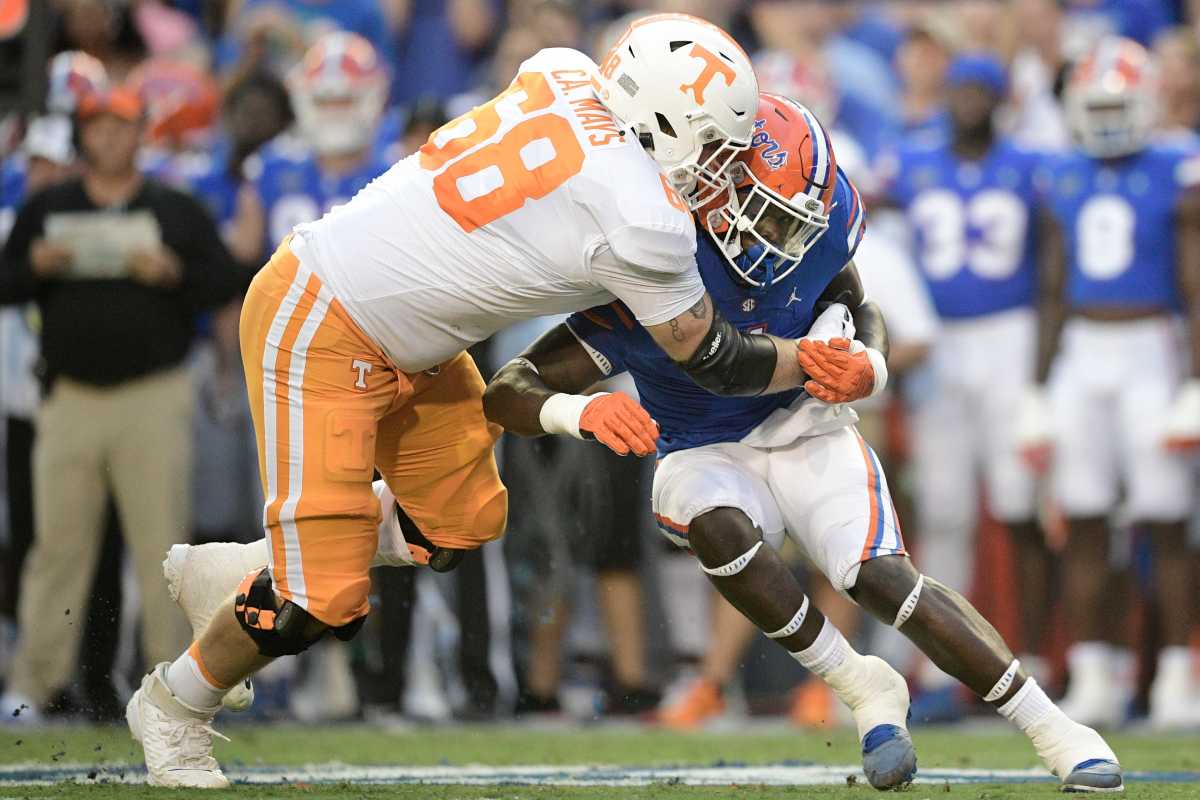
Measureables: 6-4 5/8, 311. 34 1/8 arms. 5.24 40, 4.63 shuttle, 21 bench.
Analytical stats: Mays was a Freshman All-American at Georgia in 2018 and an all-conference performer at Tennessee in 2021. He started 35 games at four positions, including 18 at right guard his first three seasons and 10 at right tackle as a senior. According to PFF, he allowed just one sack and five pressures. According to Sports Info Solutions, backs averaged 3.0 yards before contact on runs to his gap, fourth among the 24 guards it ranked in the draft class. Backs bounced the run past his gap 29 percent of the time, good for seventh. He was not flagged for holding.
Personal touch: Mays has some football genetics. His father, Kevin, was an all-SEC offensive lineman whose NFL dreams were dashed by a knee injury. His younger brother, Cooper, has started nine games at center in two seasons with the Vols.
“We weren’t like the neighborhood kids who kind of clicked with the younger kids,” Cade Mays told Saturday Down South. “It was just me and him. So, we did everything together from basketball, we’d have Airsoft wars, we’d build forts out in the woods … going to play in the creek, and it was really cool just to be able to experience that with one person … I couldn’t trade the relationship for anything.”
When Mays transferred to Tennessee, it reunited him with his younger brother on the line. “My actual first play I looked over and he was right next to me so that was unbelievable to see that become a reality,” Cade told WATE. “Afterward we talked about it and we’re just both ecstatic we get to be out on the same field at an SEC level and compete it’s just awesome.”
Sports Info Solutions Scouting Report: In the NFL, Mays projects as a starting offensive guard in any scheme, but one where he preferably doesn’t have to get out in space often. While he can struggle with some rushers out on the edge, he also has enough skill and experience to play right tackle at the next level in a backup role. However, his size, strength, power, finishing ability, and toughness suggests that his the best positional fit both short-term and long-term is at guard.
G Ed Ingram, LSU
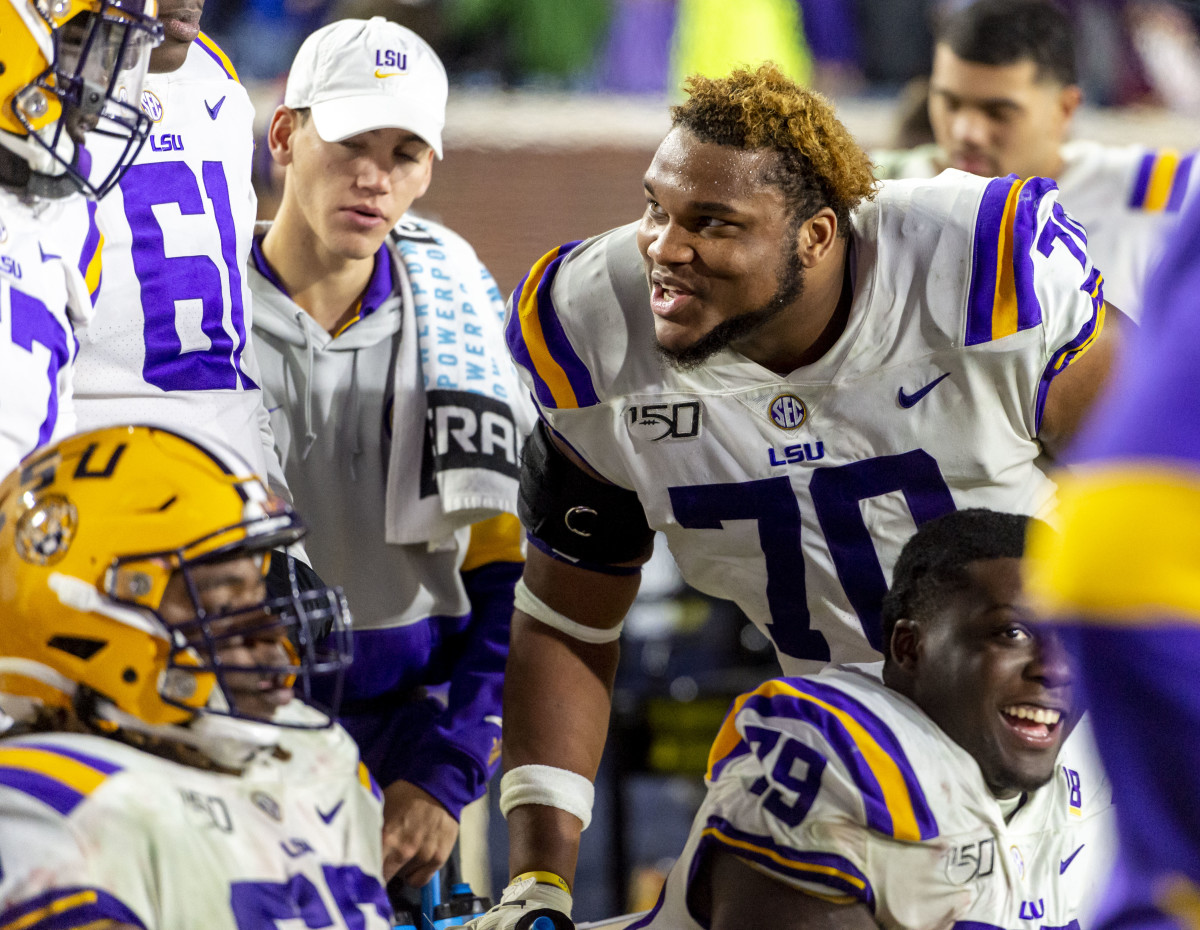
Measureables: 6-3 1/4, 307. 33 5/8 arms. 5.02 40, 4.76 shuttle, DNP bench.
Analytical stats: Ingram started 35 times at the guard positions during his five seasons with LSU. He allowed two sacks and finished 20th among guards in the draft class in PFF’s pass-blocking efficiency. According to Sports Info Solutions, backs averaged 2.9 yards before contact on runs to his gap, sixth among the 24 guards it ranked in the draft class. Backs bounced the run past his gap 37 percent of the time, tied for 13th.
Personal touch: Ingram was suspended for the 2018 season following allegations of sexual assault. He was reinstated in 2019 and the charges were dismissed. Ingram was voted the team’s top offensive lineman at the Senior Bowl.
NFL Draft Bible Scouting Report: Ingram is a very good athlete with very quick feet and the ability to work in space. His athleticism is apparent when asked to pull, staying low and delivering a blow. Ingram is aggressive at the line of scrimmage, creating a push with good leverage and explosiveness out of his hips. He can wrestle and twist opponents to finish. Understanding run schemes, Ingram seals lanes and works favorable angles around the line of scrimmage.
C/G Dawson Deaton, Texas Tech
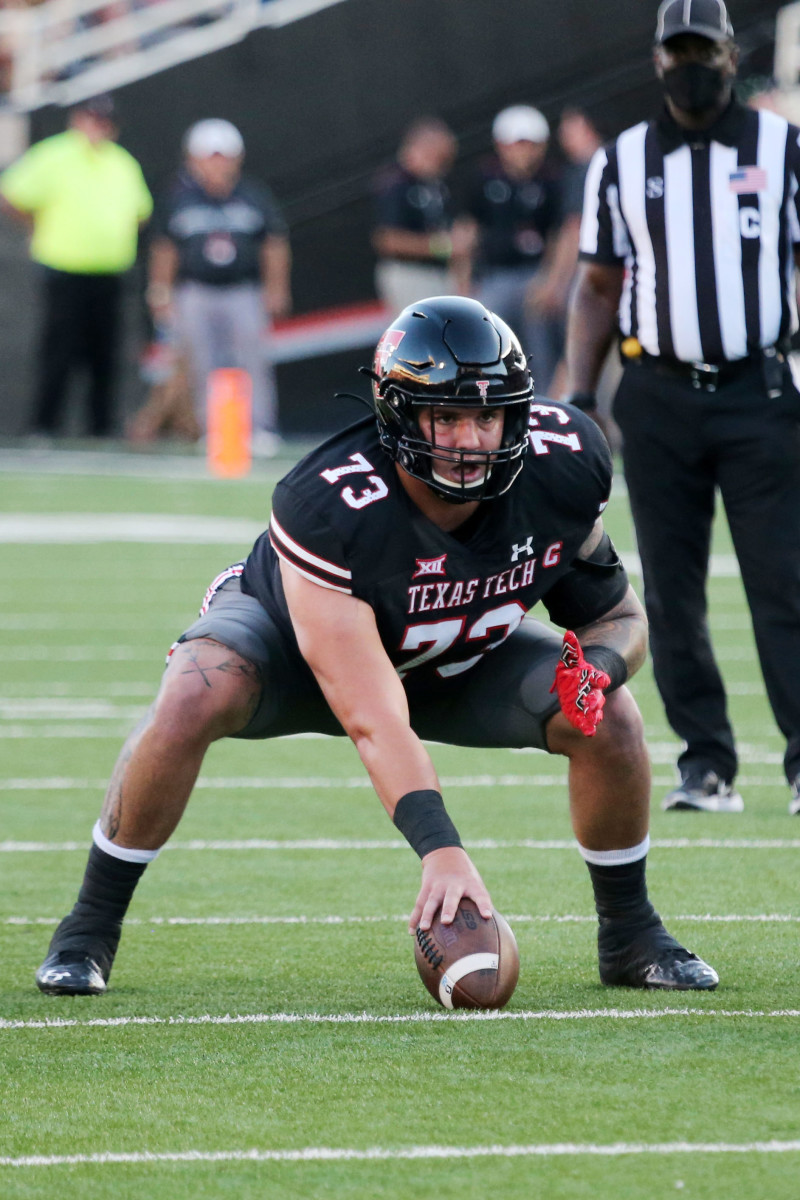
Measureables: 6-5 1/2, 306. 32 7/8 arms. 5.12 40, 4.49 shuttle, 24 bench.
Analytical stats: Of Deaton’s 35 career starts, 33 came at center. He was second-team all-Big 12 his final two seasons. According to PFF, he allowed one sack and finished fourth among centers in the draft class in its pass-blocking efficiency. According to Sports Info Solutions, backs averaged 2.6 yards before contact on runs to his gap, fourth out of 19 centers it ranked in the draft class. Backs bounced the run past his gap 39 percent of the time, good for 16th.
Personal touch: Family is a big part of life for Deaton. He became a father on Halloween 2019. He wrote about it for a photo essay on the Texas Tech athletics website. “I’ll tell you, win or lose, there’s no better feeling than walking out of the locker room, heading to see my family and seeing that smiling face waiting on me. She’s normally in a Tech cheerleader outfit or even a football jersey with my No. 73 and our last name on the back.”
An older brother, Jaxson, was an offensive lineman for Army.
Don’t tell him about Pro Football Focus (or have him read this story, which references PFF). “I don’t really care about PFF,” Deaton told Lubbock Online. “They don’t know what our coaches want from us each play. As far as the grading goes, they don’t know what our assignment is. I don’t really read into what PFF says for that reason.”
NFL Draft Bible Scouting Report: Succeeds in pass protection with a wide base that allows him to stay balanced throughout each rep. Deaton has the size and positional versatility to play at any position along the offensive line. Moves well for his size and has shown he can move linearly and laterally. He can hang his hat on his anchor and lower body strength to be a consistent blocker. Didn’t have a ton of exposure to the running game in the Texas Tech pass-heavy offense, but showed he was capable of being a run blocker.
C/G Alec Lindstrom, Boston College
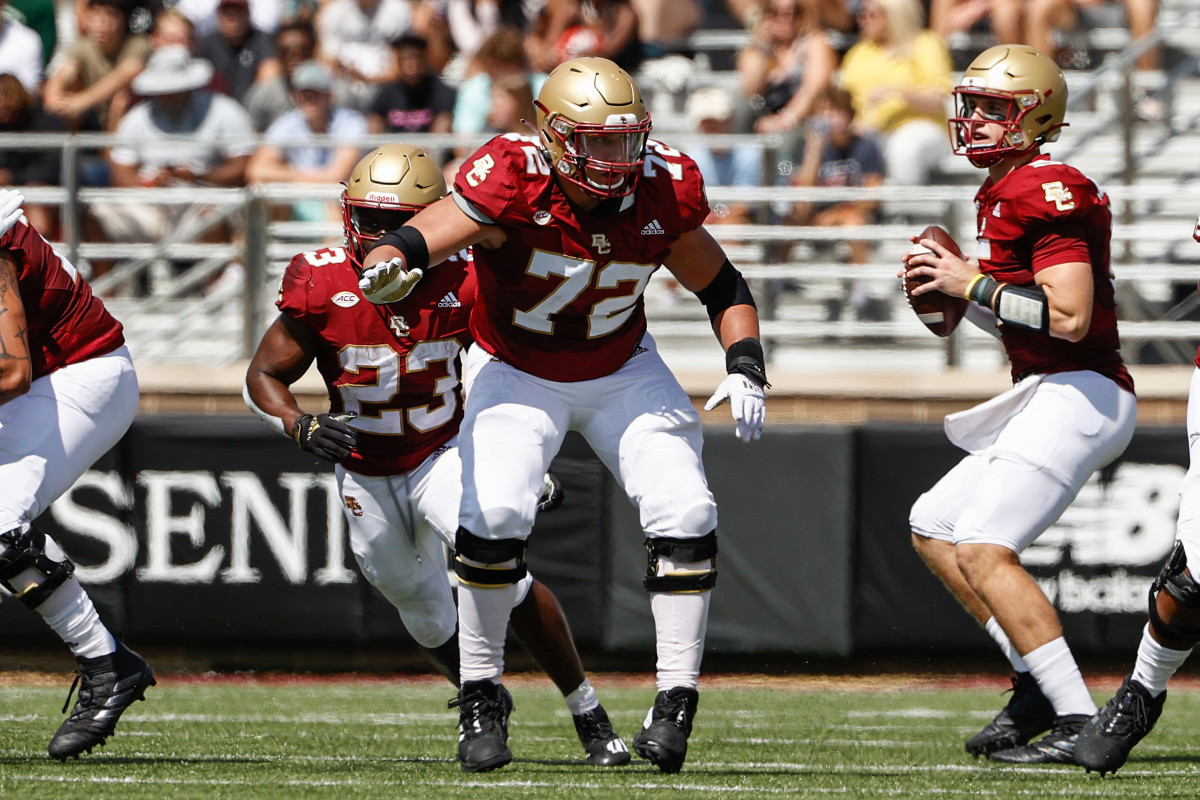
Measureables: 6-3 3/8, 296. 32 5/8 arms. 5.18 40, 4.66 shuttle, 25 bench.
Analytical stats: Lindstrom was a 37-game starter at center, earning first-team all-ACC honors his final two years. He allowed one sack and ranked 14th among centers in the draft class in PFF’s pass-blocking efficiency. According to SIS, he was in the middle of the pack among centers with 2.1 yards before contact and a bounce rate of 38 percent.
Personal touch: Lindstrom’s older brother also played on Boston College’s offensive line and was a first-round pick by the Falcons in 2019. Their dad, Chris Sr., played on the BC defensive line and was drafted by the St. Louis Rams.
“Chris is my biggest supporter,” Alec said at the Scouting Combine. “He helps me out so much, whether it was the (East-West) Shrine (Bowl) — he was like, ‘Hey, you’ve got to do this better’ — or coming here. It’s a really stressful process with the interviews, the medical stuff; I never got an MRI before until yesterday. All that stuff can be stressful, and he was just like: ‘Hey, relax. You’ve got to be genuine. You’ve got to be yourself.’ Having that resource, I’m so lucky for that.”
Would he rather play with or against his brother in the NFL? “I’ve always played with Chris. In high school, I played with him. We had bunk beds all throughout high school. In college, we were roommates. So I’ve always been with him. I think it would be pretty cool to play with him again, too, but, if I played against him, that little, ‘Oh, I’m going to beat you,’ and he’s like, ‘Oh, no, I’m going to beat you.’ Either way it would be pretty cool.”
Just before Christmas, their mother lost her battle against cancer. “I do it for her. I know she was smiling down and proud of me, proud of all of us and so happy, I knew she was with me yesterday [at the Combine],” Alec Lindstrom told New England Football Journal. “That’s what got me through this week. I knew she was with me when it was hard and thinking about her, that’s what got me through it.”
NFL Draft Bible Scouting Report: Alec Lindstrom can do it all from the center position. In the pass game, Lindstrom uses excellent football intelligence to cover both a-gaps effectively while vertical setting. He creates tons of power in his hips to move guys on double teams. Lindstrom uses effective feet in the pass game and can slide back and forth well. He uses tremendous ankle flexibility to handle the bull rush. In the run game, he uses his powerful base to clear gaps. He has an excellent reach block that he quickly is able to get his head across the defender and keep it there. When asked to get to the second level he is solid and able to connect with defenders.
G Nick Zakelj, Fordham
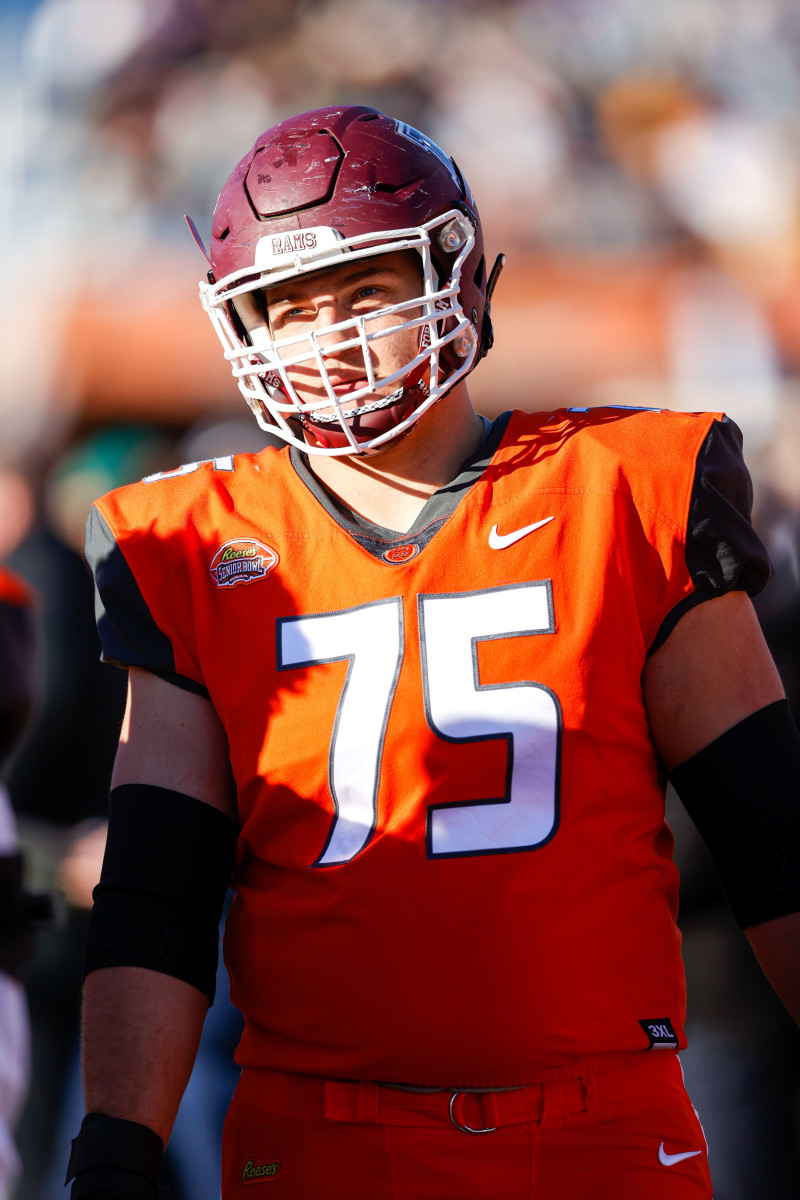
Measureables: 6-6 1/8, 316. 32 1/2 arms. 5.13 40, 4.71 shuttle, 27 bench.
Analytical stats: Zakelj started at right tackle as a freshman in 2017 and at left tackle as a super-senior in 2021. During that final season, he was a first-team FCS All-American. According to PFF, he allowed three sacks and 13 total pressures in 2021 while facing obviously lesser competition.
Personal touch: Zakelj was a late bloomer. He played linebacker throughout his high school career until a late growth spurt set him to the offensive line.
“O-line just became natural with all the kind of athleticism I still had from my linebacker-playing days,” he told The Athletic. “I had a couple MAC schools reach out pretty late in the (recruiting) process. But at that time, I was already committed to Fordham. I was really content with the academic success I was able to have at Fordham.”
COVID wiped out the 2020 season – it eventually was moved to Spring 2021 – so that allowed him to focus on his studies in finance. As he told the school: “COVID has affected eligibility in ways that I’ll be able to play for another year—while pursuing a master’s degree in the business school after graduating in May. That’s something that I wouldn’t have been able to do, so I try to take it as a blessing in disguise, really. And my goal of getting drafted into the NFL is the same; it’s just pushed back. I can’t wait to put on the jersey, whether that’s in the spring or next fall.”
NFL Draft Bible Scouting Report: In pass protection sets, his lateral foot movement is very smooth and calculated. He can keep up with and mirror pass rushers’ initial paths to the pocket. Has the ability to regain balance and leverage as edge rushers attempt to drive into his body. Always attempts to use motorized leg drive, if nothing else. He brings some athleticism to the table, being able to pull to the inside as a lead blocker.
C/G Luke Wattenberg, Washington
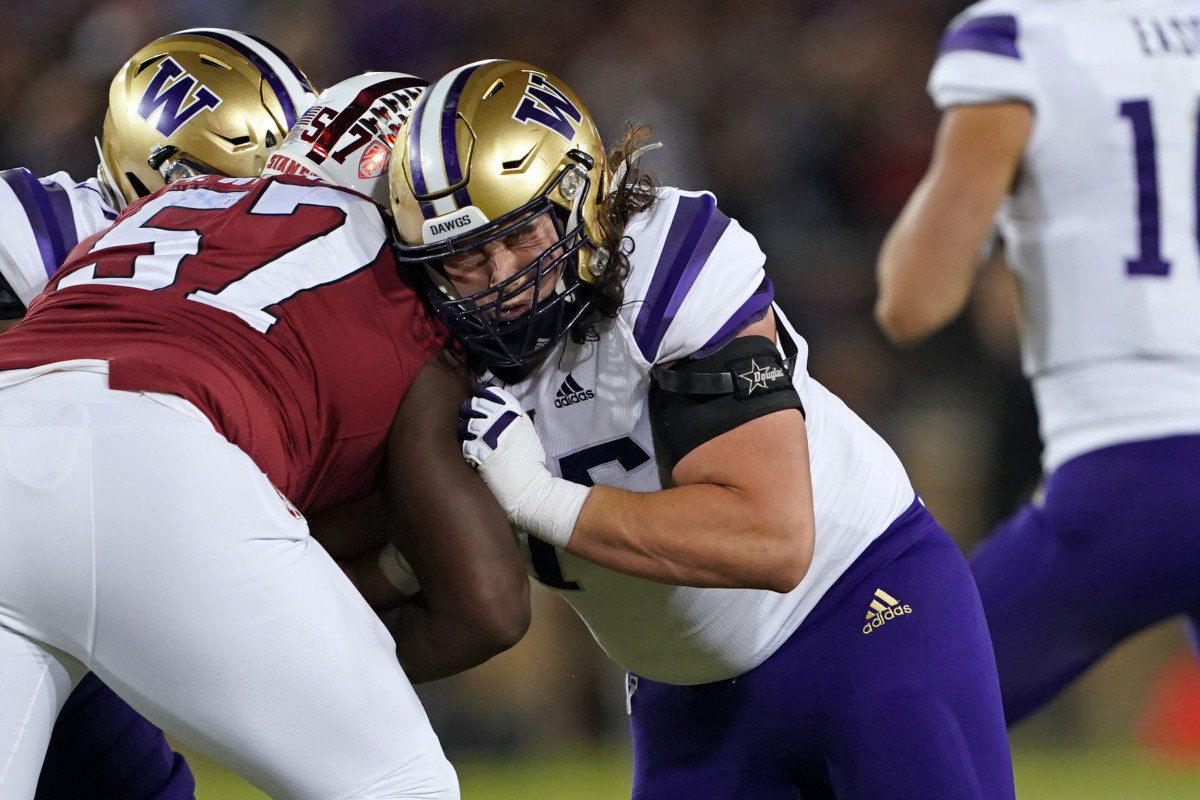
Measureables: 6-4, 299. 34 1/8 arms. 5.20 40, 4.57 shuttle, DNP bench.
Analytical stats: Wattenberg started five games at left tackle in 2017, 27 games at left guard in 2018 and 2019 and all 16 games at center in 2020 and 2021. He was an honorable mention on the all-Pac-12 team during his center seasons. He allowed one sack and ranked 33rd among centers in the draft class in PFF’s pass-blocking efficiency. According to Sports Info Solutions, backs averaged 1.8 yards before contact on runs to his gap, 18th out of 19 centers it ranked in the draft class. Backs bounced the run past his gap 32 percent of the time, good for seventh.
Personal touch: Wattenberg set school records with 54 games and 48 starts. He replaced Nick Harris, a fifth-round pick in 2020 with 23 NFL games under his belt, as the center for his final two seasons. Wattenberg and Harris were high school teammates in California. They were coached at JSerra by former NFL lineman Pat Harlow.
“Harlow is an unbelievable coach; there’s not many high school coaches that teach what he does,” Wattenberg told The Pasadena Star-News. “It’s almost college-level the stuff that he teaches, like technique and developing players. A lot of the stuff we were doing at JSerra, we do here [at Washington].”
NFL Draft Bible Scouting Report: Very good in pass protection, he is able to get the snap off quickly and get his hands back to blocking position. Powerful base with good hip movement. He is good at sealing off lanes and spinning his hips to get back to the proper position. Moves upfield very well and is great at staying on his path. Strong hands, once he has a good grip of a defender it is very difficult for them to get away from him.
